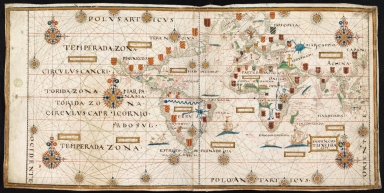Detail View: Old Maps Collection: [Planisphère]

|
Barcode:
|
3687800354090A
|
|
Title:
|
[Planisphère]
|
|
Other Title:
|
Mapa Mundi de Domingos Teixeira
|
|
Other Title:
|
Teixeira planisphere
|
|
Contributor:
|
Teixeira, Domingos, fl. 1565-1595, cartographer
|
|
Category:
|
Sea Charts
|
|
Type:
|
Manuscripts
|
|
Language:
|
Portuguese
|
|
Language:
|
Latin
|
|
Create Year:
|
1573
|
|
Format:
|
JPEG2, 16115 x 8099, 20MB
|
|
Scale:
|
Scale not given.
|
|
Physical Map Dimension (cm):
|
30 x 60 cm, on sheet 35 x 64 cm
|
|
Note:
|
This is one of the first mappa mundi to show the spice routes, both the Portuguese east route of Vasco da Gama (ca. 1460-1524), and the Spanish west route by Ferdinand Magellan (ca. 1480-1521). It is depicted the Tordesillas Meridian both on Brazil and at the opposite side of the world at the Philippines, that according to the Treaty of Zaragoza should belong to Portugal, as they are in the Portuguese hemisphere. Actually the Meridian is the center of the map and not Europe as in more common representations. The Maluku Islands are placed on the far left side of the map beyond the latitude line, together with the Equator, on a blank space, placing them under Spanish rule.
|
|
Note:
|
Original is a manuscript map on parchment, 48 x 98 cm, on sheet 49 x 100 cm.
|
|
Note:
|
Title from provenance library.
|
|
Note:
|
The territories are marked with coats of arms from the country administering it, mostly Portugal and Spain. Jerusalem is depicted as a Calvary. On Africa are the Elmina Castle -erected by the Portuguese in 1482 as Castelo de São Jorge da Mina- with some palm trees and in Congo there is the drawing of a catholic church, most probably Cathedral of the Holy Saviour of Congo, a simple church -named cathedral in 1596- initiated ca. 1491, under King João I of Portugal. On water masses there are eight vessels with the cross from the Order of Christ on their sails.
|
|
Note:
|
There are twenty-six 32-point compass roses on the map with four of them being only half compass rose. The five bigger compass roses and the compass rose on the continent of Africa have a fleur-de-lis indicating north and the smaller ones have an arrow. The four big compass roses on each corner of the map have a cross indicating East. All are colored red, blue, green and yellow. As for the rhumb lines, the principal winds are in black, the half-winds in green and the quarter-winds in red.
|
|
Note:
|
There are 12 table of leagues on yellow borders. The author name and date of the map is also inside a yellow cartouche.
|
|
Note:
|
There are three latitude lines on the map, one on each side of the map and one as the Meridian from the Tordesillas Treaty. All coloured white and blue interchangeably.
|
|
Note:
|
The Equator, the Tropics and the lines for Climate Zones in red.
|
|
Note:
|
Land masses outlined in green and islands colored red, blue or green. Toponyms in black and red.
|
|
Note:
|
Map outlined in a triple border coloured blue, gold and red.
|
|
Reference:
|
Cortesão, A. Portugalliae Monumenta Cartographica, vol. II, p. 121-122
|
|
Reference:
|
Cortesão, A. Cartografia e Cartógrafos Portugueses dos Séculos XV e XVI, vol. II, p. 251
|
|
Reference:
|
Dahlgren, E.W. Les débuts de la cartographie du Japon, p. 27
|
|
Reference:
|
Kammerer, A. La Mer Rouge, l'Abyssinie et l'Arabie aux XVI.e et XVII.e siècles et la cartographie des portulans du monde oriental, 3, p. 208-209
|
|
Reference:
|
Pflederer, R. Census of Portolan Charts and Atlases, p. 59
|
|
Reference:
|
Gaspar, J.A. From the Portolan Chart of the Mediterranean to the Latitude Chart of the Atlantic: Cartometric Analysis and Modelling
|
|
Subject:
|
World -- Maps
|
|
Geographic Area:
|
World
|
|
Geographic Area:
|
America
|
|
Geographic Area:
|
North America
|
|
Geographic Area:
|
Central America
|
|
Geographic Area:
|
South America
|
|
Geographic Area:
|
Europe
|
|
Geographic Area:
|
Africa
|
|
Geographic Area:
|
Asia
|
|
Provenance:
|
Bibliothèque Nationale de France
|
|
Provenance:
|
https://catalogue.bnf.fr/ark:/12148/cb40591221z
|
|
Provenance Call No.:
|
GE SH ARCH-3
|
|
MUST holding:
|
https://must.primo.exlibrisgroup.com/permalink/853MUST_INST/reglfj/alma991002923848305076
|